Spatial and Temporal Responses to an Emissions Trading Scheme Covering Agriculture and Forestry: Simulation Results from New Zealand
Abstract
:1. Introduction
2. Model Description
3. Land-Use Results
3.1. National-Level Land-Use Change
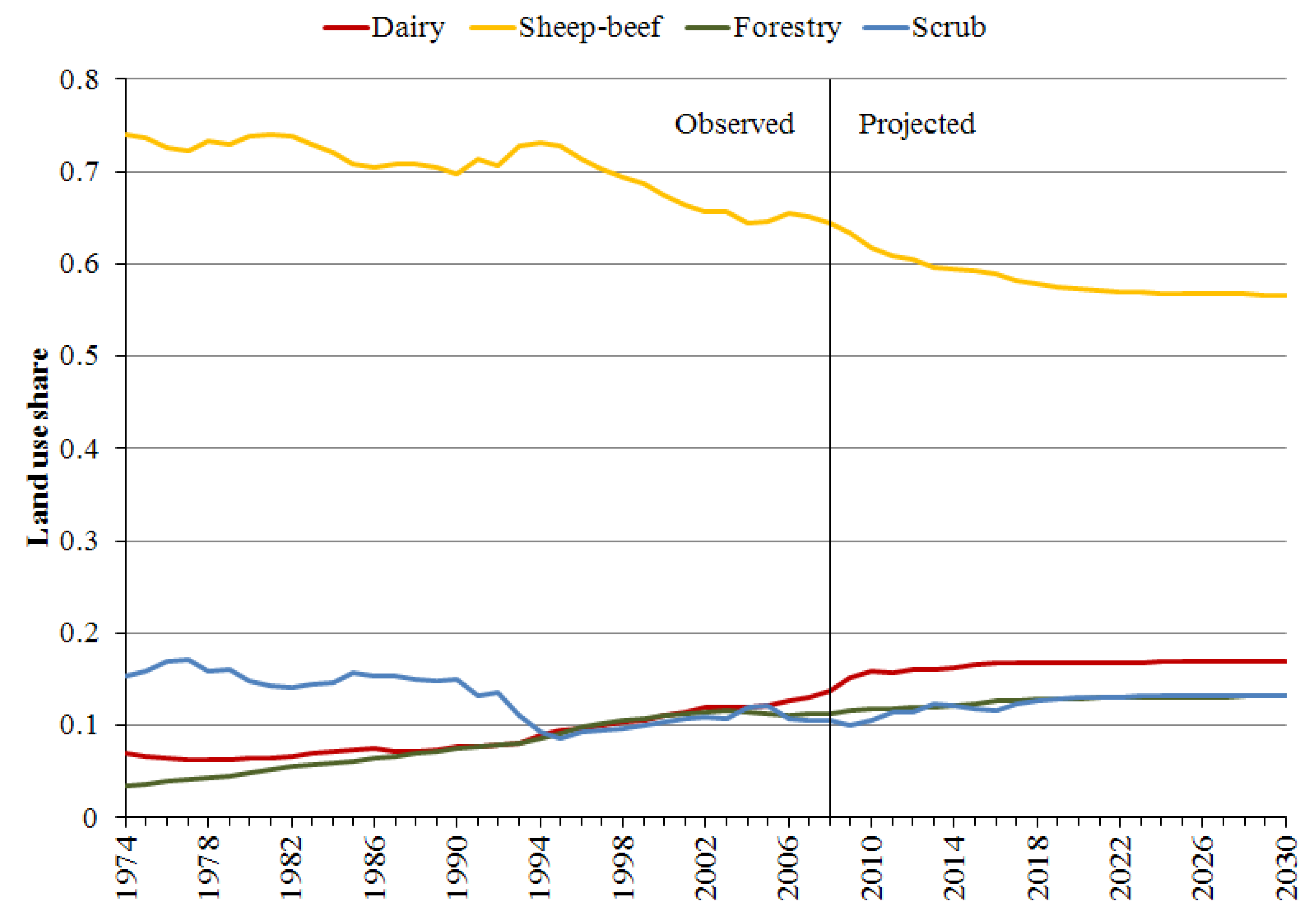
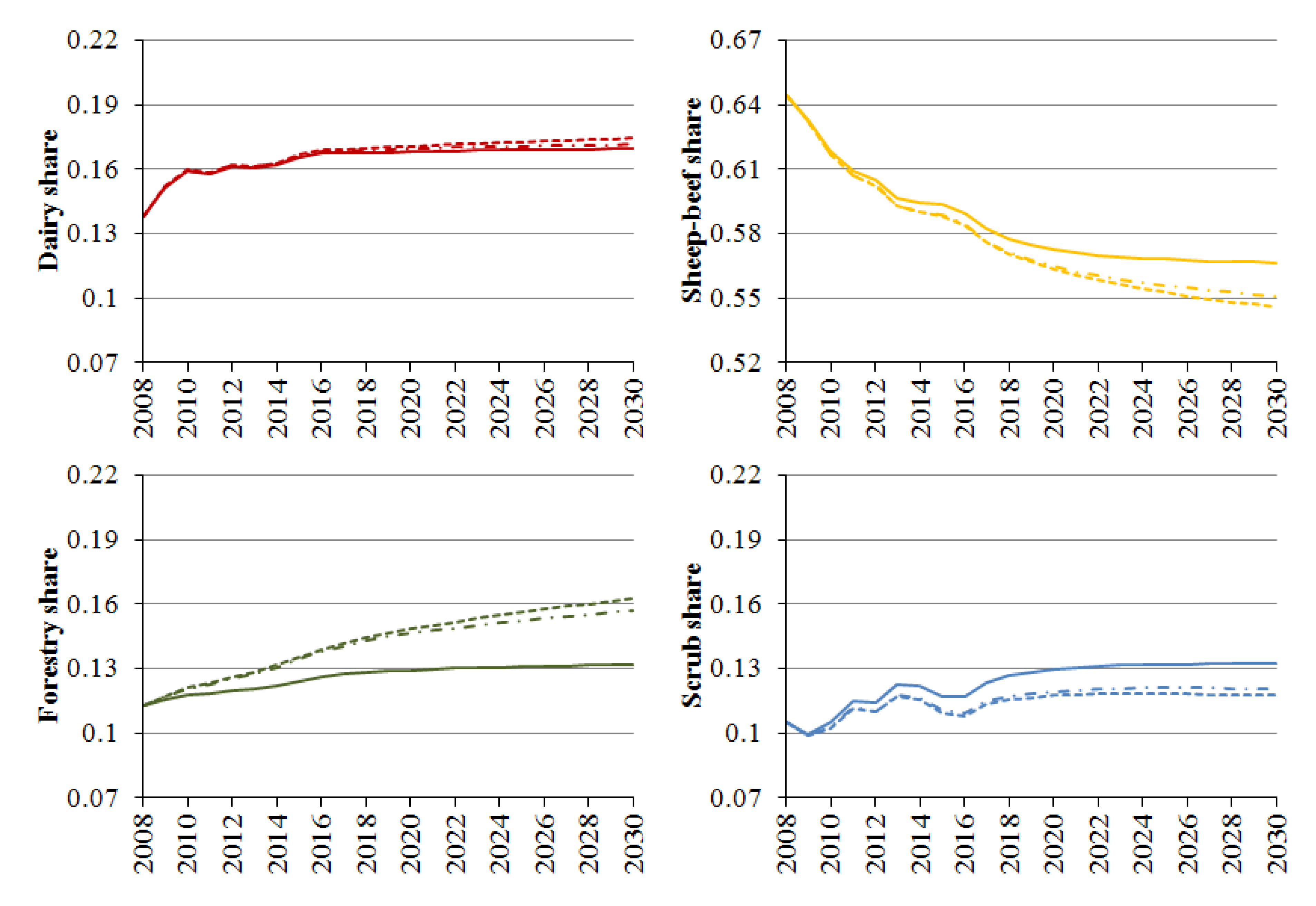
3.2. Regional Land-Use Change
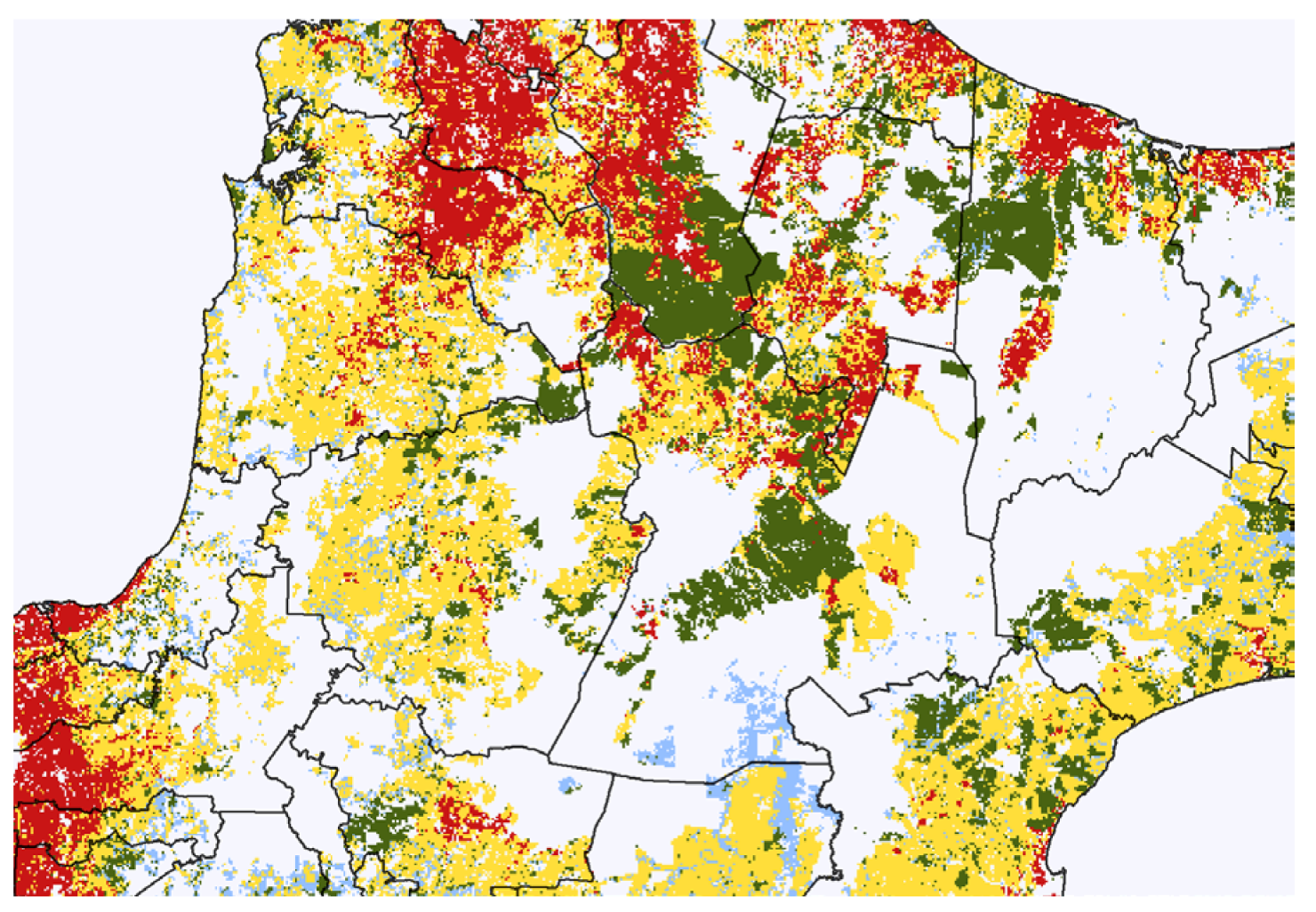
| Baseline 2030 | Dairy | Sheep-beef | Forestry | Scrub | ||||||||||||
|---|---|---|---|---|---|---|---|---|---|---|---|---|---|---|---|---|
| 2008 land use | Dairy | Sheep-beef | Forestry | Scrub | Dairy | Sheep-beef | Forestry | Scrub | Dairy | Sheep-beef | Forestry | Scrub | Dairy | Sheep-beef | Forestry | Scrub |
| Northland | 152,430 | 28,800 | 250 | 1,975 | 0 | 161,430 | 0 | 0 | 0 | 4,925 | 140,180 | 2,175 | 0 | 210,450 | 0 | 88,000 |
| Auckland | 56,350 | 25,425 | 125 | 1,500 | 0 | 95,275 | 0 | 650 | 0 | 2,950 | 37,550 | 1,375 | 0 | 31,325 | 0 | 29,675 |
| Waikato | 481,950 | 33,975 | 150 | 4,650 | 8,775 | 647,980 | 0 | 600 | 825 | 17,700 | 229,600 | 21,850 | 0 | 16,025 | 0 | 78,275 |
| Bay of Plenty | 92,000 | 5,725 | 25 | 275 | 1,900 | 127,780 | 0 | 50 | 175 | 12,225 | 139,750 | 10,200 | 0 | 5,250 | 0 | 17,225 |
| Gisborne | 2,100 | 6,575 | 25 | 0 | 0 | 264,630 | 0 | 0 | 0 | 21,625 | 137,730 | 10,350 | 0 | 64,775 | 0 | 85,050 |
| Hawke’s Bay | 19,275 | 9,750 | 0 | 6,850 | 3,225 | 656,600 | 0 | 4,350 | 25 | 10,275 | 109,350 | 12,175 | 0 | 9,800 | 0 | 64,500 |
| Taranaki | 197,200 | 4,875 | 25 | 0 | 200 | 148,280 | 0 | 3,550 | 0 | 75 | 24,150 | 16,675 | 0 | 850 | 0 | 42,125 |
| Manawatu | 133,680 | 57,375 | 150 | 1,775 | 1,425 | 964,280 | 0 | 175 | 25 | 31,825 | 112,050 | 12,125 | 100 | 72,125 | 0 | 81,875 |
| Wellington | 33,300 | 28,275 | 0 | 1,250 | 0 | 278,280 | 0 | 600 | 0 | 6,475 | 48,125 | 4,025 | 0 | 17,500 | 0 | 97,250 |
| West Coast | 76,775 | 0 | 25 | 0 | 1,250 | 63,375 | 0 | 750 | 125 | 1,250 | 29,450 | 7,475 | 25 | 225 | 0 | 9,075 |
| Canterbury | 201,980 | 76,800 | 425 | 2,050 | 1,525 | 1,261,000 | 0 | 14,100 | 0 | 675 | 93,450 | 4,375 | 0 | 21,550 | 0 | 197,480 |
| Otago | 79,550 | 26,775 | 75 | 7,550 | 700 | 1,211,300 | 0 | 3,750 | 25 | 7,400 | 111,600 | 1,175 | 75 | 61,250 | 0 | 60,900 |
| Southland | 153,230 | 59,150 | 100 | 1,175 | 0 | 600,550 | 0 | 4,850 | 0 | 25 | 66,825 | 1,950 | 0 | 0 | 0 | 29,425 |
| Tasman | 24,425 | 7,200 | 0 | 675 | 2,900 | 71,275 | 0 | 5,700 | 225 | 1,050 | 70,800 | 3,175 | 0 | 475 | 0 | 30,450 |
| Nelson | 325 | 175 | 0 | 0 | 50 | 3,550 | 0 | 225 | 0 | 25 | 7,050 | 125 | 0 | 25 | 0 | 3,375 |
| Marlborough | 10,925 | 5,775 | 0 | 225 | 1,875 | 206,150 | 0 | 800 | 0 | 0 | 55,550 | 3,100 | 0 | 0 | 0 | 77,900 |
| New Zealand | 1,715,495 | 376,650 | 1,375 | 29,950 | 23,825 | 6,761,735 | 0 | 40,150 | 1,425 | 118,500 | 1,413,210 | 112,325 | 200 | 511,625 | 0 | 992,580 |
| Full ETS 2030 | Dairy | Sheep-beef | Forestry | Scrub | ||||||||||||
|---|---|---|---|---|---|---|---|---|---|---|---|---|---|---|---|---|
| Baseline 2030 | Dairy | Sheep-beef | Forestry | Scrub | Dairy | Sheep-beef | Forestry | Scrub | Dairy | Sheep-beef | Forestry | Scrub | Dairy | Sheep-beef | Forestry | Scrub |
| Northland | 183,450 | 1,650 | 25 | 1,525 | 0 | 142,430 | 0 | 0 | 0 | 1,275 | 147,250 | 72,425 | 0 | 16,075 | 0 | 224,500 |
| Auckland | 83,400 | 1,750 | 0 | 0 | 0 | 80,175 | 0 | 0 | 0 | 10,725 | 41,875 | 28,225 | 0 | 3,275 | 0 | 32,775 |
| Waikato | 520,730 | 6,950 | 125 | 50 | 0 | 633,700 | 0 | 0 | 0 | 11,850 | 269,850 | 28,300 | 0 | 4,850 | 0 | 65,950 |
| Bay of Plenty | 98,025 | 1,825 | 200 | 0 | 0 | 122,500 | 0 | 0 | 0 | 3,375 | 162,150 | 3,525 | 0 | 2,025 | 0 | 18,950 |
| Gisborne | 8,700 | 800 | 0 | 0 | 0 | 237,750 | 0 | 0 | 0 | 10,700 | 169,700 | 29,625 | 0 | 15,375 | 0 | 120,200 |
| Hawke’s Bay | 35,875 | 1,950 | 0 | 50 | 0 | 653,550 | 0 | 0 | 0 | 3,925 | 131,830 | 12,775 | 0 | 4,750 | 0 | 61,475 |
| Taranaki | 202,100 | 625 | 0 | 0 | 0 | 147,900 | 0 | 0 | 0 | 1,725 | 40,900 | 15,075 | 0 | 1,775 | 0 | 27,900 |
| Manawatu | 192,980 | 5,050 | 75 | 0 | 0 | 917,680 | 0 | 0 | 0 | 28,725 | 155,950 | 42,225 | 0 | 14,425 | 0 | 111,880 |
| Wellington | 62,825 | 2,950 | 0 | 0 | 0 | 259,930 | 0 | 0 | 0 | 6,825 | 58,625 | 20,475 | 0 | 9,175 | 0 | 94,275 |
| West Coast | 76,800 | 475 | 25 | 25 | 0 | 63,450 | 0 | 0 | 0 | 1,300 | 38,275 | 1,875 | 0 | 150 | 0 | 7,425 |
| Canterbury | 281,250 | 11,875 | 75 | 175 | 0 | 1,251,300 | 0 | 0 | 0 | 1,050 | 98,425 | 5,375 | 0 | 12,425 | 0 | 213,480 |
| Otago | 113,950 | 7,825 | 0 | 100 | 0 | 1,187,200 | 0 | 0 | 0 | 8,575 | 120,200 | 7,075 | 0 | 12,175 | 0 | 115,050 |
| Southland | 213,650 | 10,650 | 0 | 300 | 0 | 592,380 | 0 | 0 | 0 | 600 | 68,800 | 150 | 0 | 1,775 | 0 | 28,975 |
| Tasman | 32,300 | 1,425 | 0 | 125 | 0 | 74,400 | 0 | 0 | 0 | 2,225 | 75,250 | 6,925 | 0 | 1,825 | 0 | 23,875 |
| Nelson | 500 | 25 | 0 | 0 | 0 | 3,550 | 0 | 0 | 0 | 75 | 7,200 | 800 | 0 | 175 | 0 | 2,600 |
| Marlborough | 16,925 | 675 | 0 | 0 | 0 | 206,500 | 0 | 0 | 0 | 850 | 58,650 | 1,750 | 0 | 800 | 0 | 76,150 |
| New Zealand | 2,123,460 | 56,500 | 525 | 2,350 | 0 | 6,574,395 | 0 | 0 | 0 | 93,800 | 1,644,930 | 276,600 | 0 | 101,050 | 0 | 1,225,460 |
| Full ETS 2030 | Dairy | Sheep-beef | Forestry | Scrub | ||||||||||||
|---|---|---|---|---|---|---|---|---|---|---|---|---|---|---|---|---|
| ETS no ag 2030 | Dairy | Sheep-beef | Forestry | Scrub | Dairy | Sheep-beef | Forestry | Scrub | Dairy | Sheep-beef | Forestry | Scrub | Dairy | Sheep-beef | Forestry | Scrub |
| Northland | 184,580 | 775 | 25 | 1,275 | 0 | 142,430 | 0 | 0 | 0 | 0 | 198,430 | 22,525 | 0 | 3,050 | 0 | 237,530 |
| Auckland | 84,000 | 1,150 | 0 | 0 | 0 | 80,175 | 0 | 0 | 0 | 1,350 | 75,975 | 3,500 | 0 | 475 | 0 | 35,575 |
| Waikato | 524,900 | 2,850 | 75 | 25 | 0 | 633,700 | 0 | 0 | 0 | 2,650 | 302,830 | 4,525 | 0 | 1,250 | 0 | 69,550 |
| Bay of Plenty | 99,125 | 800 | 125 | 0 | 0 | 122,500 | 0 | 0 | 0 | 625 | 168,050 | 375 | 0 | 500 | 0 | 20,475 |
| Gisborne | 9,000 | 500 | 0 | 0 | 0 | 237,750 | 0 | 0 | 0 | 1,850 | 203,950 | 4,225 | 0 | 2,150 | 0 | 133,430 |
| Hawke’s Bay | 36,825 | 1,000 | 0 | 50 | 0 | 653,530 | 0 | 25 | 0 | 500 | 146,400 | 1,625 | 0 | 450 | 0 | 65,775 |
| Taranaki | 202,330 | 400 | 0 | 0 | 0 | 147,900 | 0 | 0 | 0 | 150 | 55,900 | 1,650 | 0 | 100 | 0 | 29,575 |
| Manawatu | 195,000 | 3,050 | 50 | 0 | 0 | 917,680 | 0 | 0 | 0 | 4,650 | 216,750 | 5,500 | 0 | 2,250 | 0 | 124,050 |
| Wellington | 63,950 | 1,825 | 0 | 0 | 0 | 259,930 | 0 | 0 | 0 | 1,425 | 81,050 | 3,450 | 0 | 1,550 | 0 | 101,900 |
| West Coast | 77,150 | 150 | 25 | 0 | 0 | 63,450 | 0 | 0 | 0 | 475 | 40,625 | 350 | 0 | 25 | 0 | 7,550 |
| Canterbury | 285,630 | 7,675 | 25 | 50 | 0 | 1,251,200 | 0 | 50 | 0 | 275 | 103,650 | 925 | 0 | 1,300 | 0 | 224,600 |
| Otago | 117,030 | 4,825 | 0 | 25 | 0 | 1,187,200 | 0 | 25 | 0 | 1,425 | 133,280 | 1,150 | 0 | 1,750 | 0 | 125,480 |
| Southland | 218,100 | 6,275 | 0 | 225 | 0 | 592,380 | 0 | 0 | 0 | 225 | 69,300 | 25 | 0 | 75 | 0 | 30,675 |
| Tasman | 33,150 | 675 | 0 | 25 | 0 | 74,400 | 0 | 0 | 0 | 625 | 82,500 | 1,275 | 0 | 25 | 0 | 25,675 |
| Nelson | 525 | 0 | 0 | 0 | 0 | 3,550 | 0 | 0 | 0 | 25 | 7,900 | 150 | 0 | 0 | 0 | 2,775 |
| Marlborough | 17,250 | 350 | 0 | 0 | 0 | 206,500 | 0 | 0 | 0 | 275 | 60,875 | 100 | 0 | 175 | 0 | 76,775 |
| New Zealand | 2,148,545 | 32,300 | 325 | 1,675 | 0 | 6,574,275 | 0 | 100 | 0 | 16,525 | 1,947,465 | 51,350 | 0 | 15,125 | 0 | 1,311,390 |
4. Agricultural Emissions
| Baseline land use | ||||
|---|---|---|---|---|
| Full ETS land use | Dairy | Sheep-beef | Forest | Scrub |
| Dairy | 0 | 0.232 | 0.004 a | 0.016 a |
| Sheep-beef | 0 | 0 | 0 | 0 |
| Forest | 0 | −0.240 | 0 | 0 |
| Scrub | 0 | −0.263 | 0 | 0 |
| Net | 0 | −0.271 | 0.004 | 0.016 |
5. The Time Path of Policy-induced Net Forestry Emissions
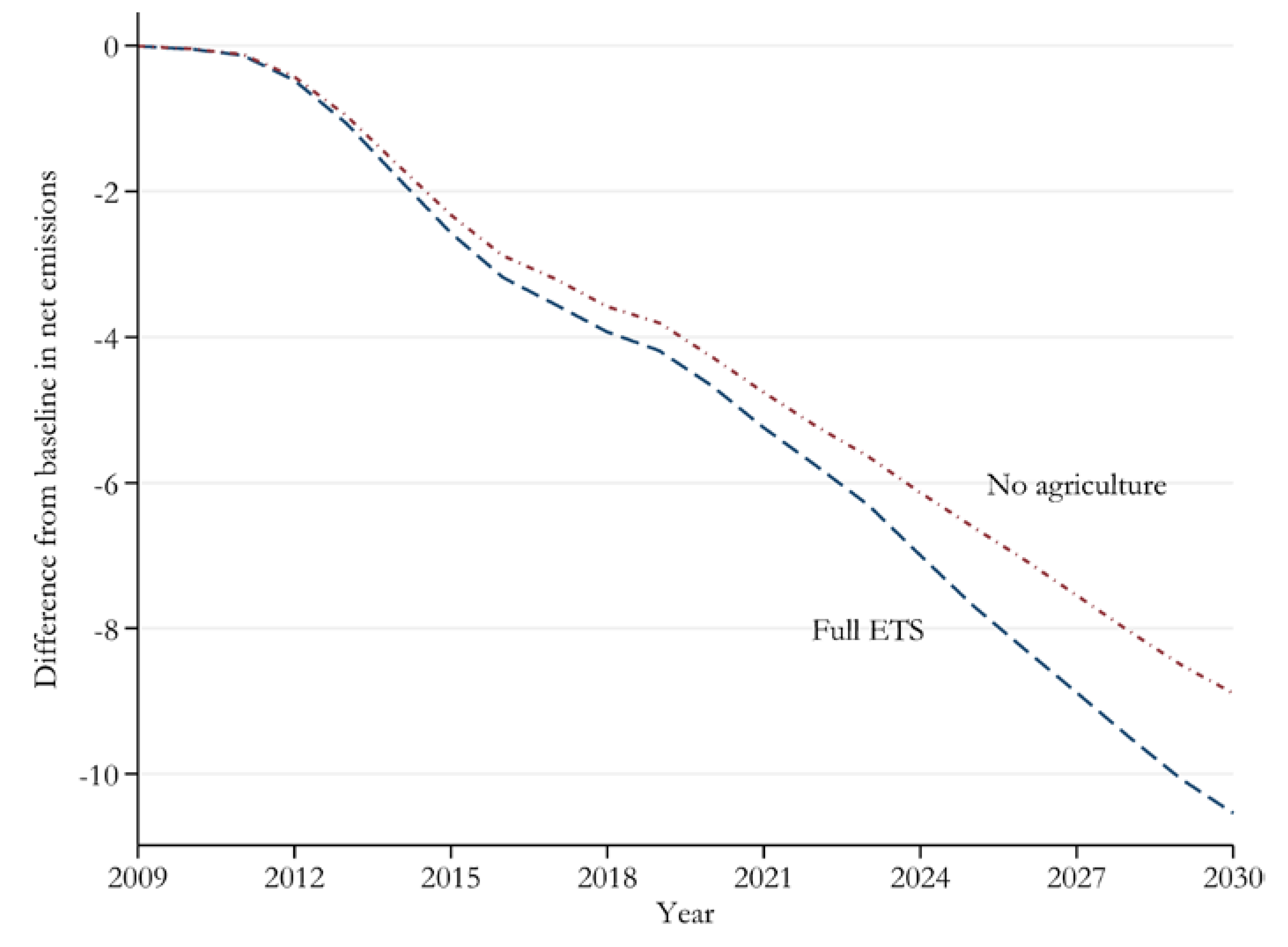
6. Production
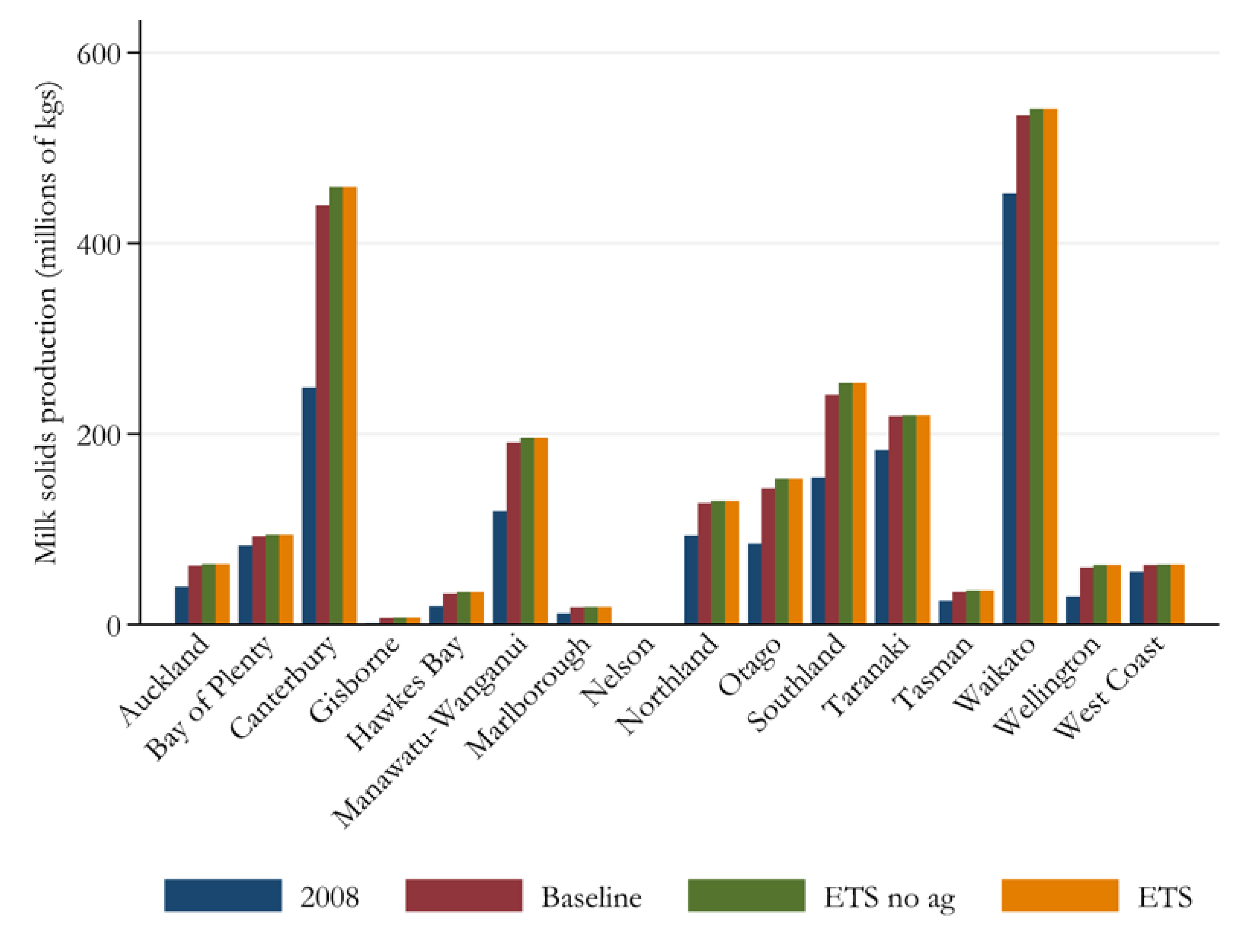
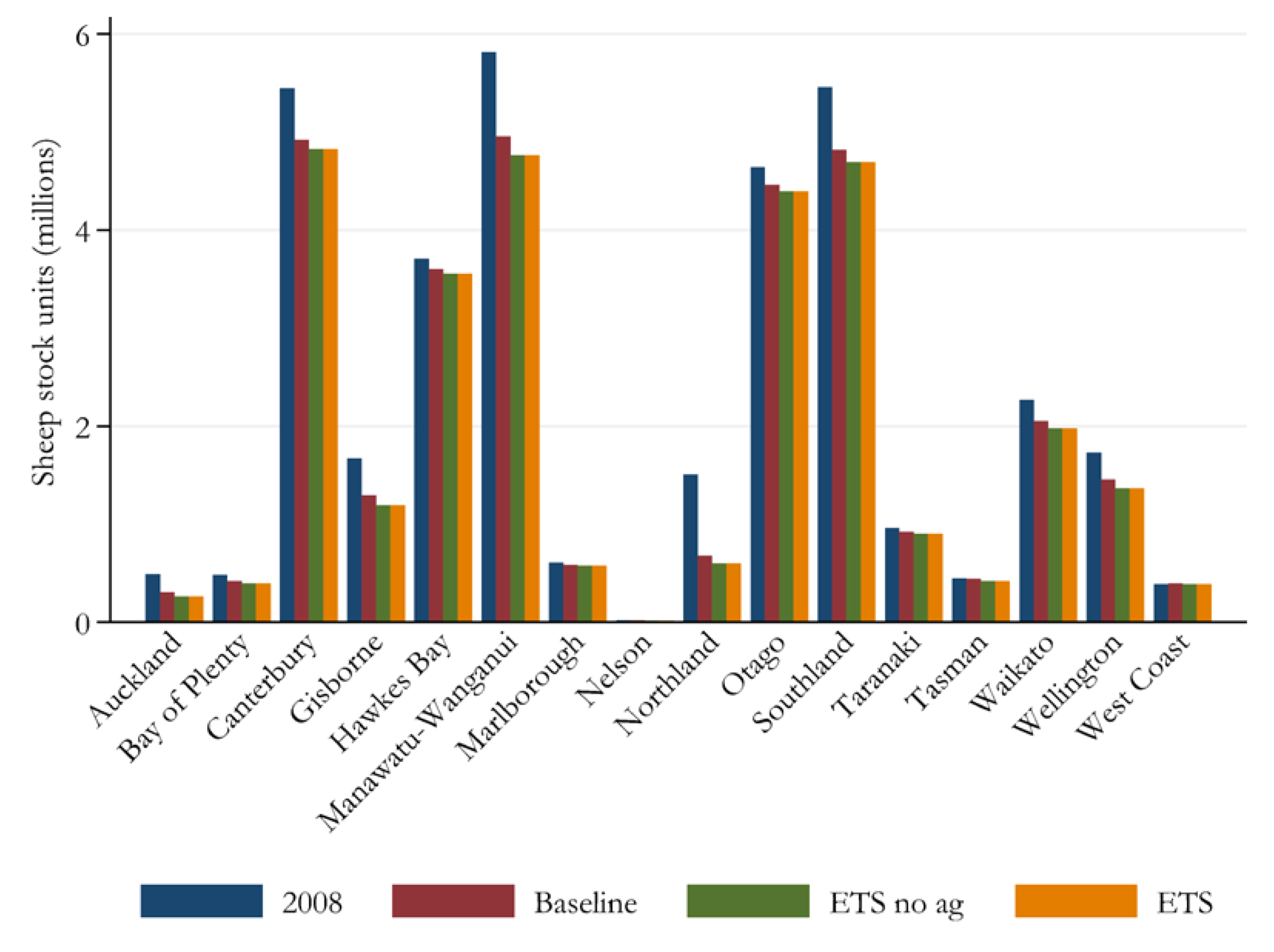

7. Conclusions
Appendix on National Land-use Modeling in LURNZ
Price Projections
Modeling the Impact of Carbon Prices
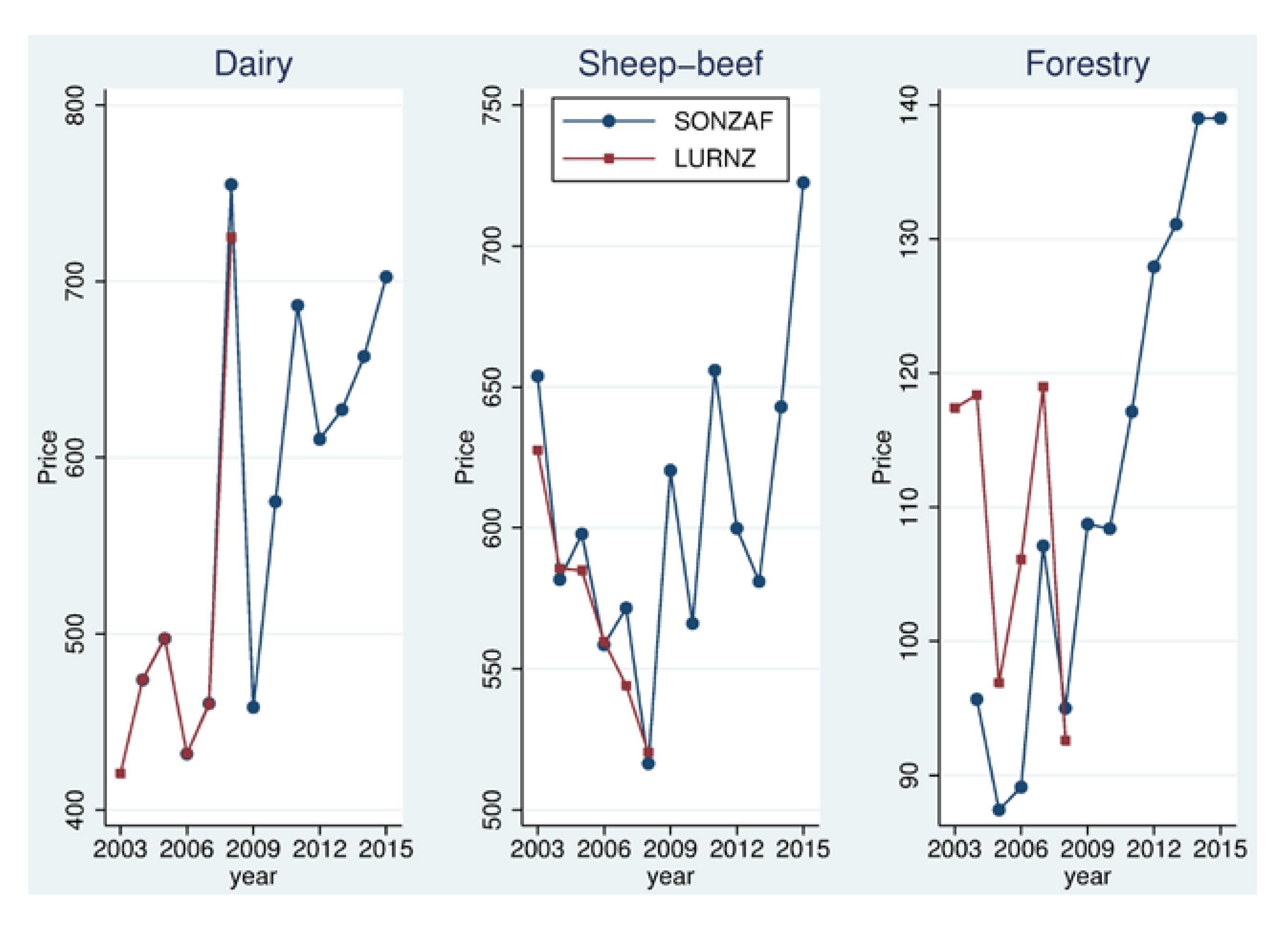
| Year | Dairy price | Sheep-beef price | Forestry price | Int. rate | ||||||
| BL | ETS 1 | ETS 2 | BL | ETS 1 | ETS 2 | BL | ETS 1 | ETS 2 | All | |
| 2008 | 725.0 | 721.9 | 721.9 | 520.4 | 490.1 | 490.1 | 92.6 | 109.1 | 109.1 | 6.17 |
| 2009 | 458.3 | 455.1 | 455.1 | 620.5 | 590.2 | 590.2 | 108.7 | 125.3 | 125.3 | 3.70 |
| 2010 | 580.6 | 577.5 | 577.5 | 571.7 | 541.5 | 541.5 | 109.5 | 126.0 | 126.0 | 2.70 |
| 2011 | 683.1 | 680.0 | 680.0 | 652.9 | 622.6 | 622.6 | 116.6 | 133.1 | 133.1 | 3.00 |
| 2012 | 606.9 | 603.8 | 603.8 | 596.5 | 566.2 | 566.2 | 127.2 | 143.8 | 143.8 | 3.00 |
| 2013 | 627.2 | 624.1 | 624.1 | 581.1 | 550.9 | 550.9 | 131.1 | 147.7 | 147.7 | 3.90 |
| 2014 | 660.7 | 657.6 | 638.2 | 646.2 | 616.0 | 562.5 | 139.7 | 156.3 | 156.3 | 4.70 |
| 2015 | 708.8 | 705.7 | 686.4 | 729.0 | 698.8 | 645.1 | 140.3 | 156.8 | 156.8 | 5.00 |
Modeling Decisions
Conflict of Interest
Acknowledgements
References and Notes
- Anastasiadis, S.; Kerr, S. Mitigation and heterogeneity in management practices on New Zealand dairy farms. Unpublished manuscript.
- Jiang, N.; Sharp, B.; Sheng, M. New Zealand’s emissions trading scheme. New Zeal. Econ. Papers 2009, 43, 69–79. [Google Scholar] [CrossRef]
- Bertram, G.; Terry, S. The Carbon Challenge: New Zealand’s Emissions Trading Scheme; Bridget Williams Books: Wellington, New Zealand, 2010. [Google Scholar]
- Agriculture’s entry has been deferred by an amendment to ETS legislation passed in November 2012. There has been no change to the mandatory reporting requirement of agricultural emissions, which started at the beginning of 2012. All other sectors of the economy have either already entered the ETS in 2010 or are scheduled to enter it in 2013.
- Indigenous forests are protected in New Zealand and can almost never be logged.
- Karpas, E.; Kerr, S. Preliminary Evidence on Responses to the New Zealand Forestry Emissions Trading Scheme; Motu Working Paper 11-09. 2010. Available online: http://motu-www.motu.org.nz/wpapers/11_09.pdf (accessed on 25 September 2012).
- Ministry of Agriculture and Forestry. A Guide to Reporting for Agricultural Activities under the New Zealand Emissions Trading Scheme. 2011. Available online: http://www.mpi.govt.nz/news-resources/publications (accessed on 25 September 2012).
- To facilitate this comparison, we do not include a free allocation to agriculture in our full ETS scenario. Agricultural participants are therefore liable for all of their emissions starting from 2015 in our scenario.
- Manley, B.; Maclaren, P. Potential impact of carbon trading on forest management in New Zealand. For. Policy Econ. 2012, 24, 34–40. [Google Scholar]
- Turner, J.A.; West, G.; Dungey, H.; Wakelin, S.; Maclaren, P.; Adams, T.; Silcock, P. Managing New Zealand Planted Forests for Carbon: A Review of Selected Management Scenarios and Identification of Knowledge Gaps; Scion Ltd. Report; Ministry of Agriculture and Forestry: Wellington, New Zealand, 2008. Available online: http://www.mpi.govt.nz/news-resources/publications (accessed on 25 September 2012).
- Kerr, S.; Olssen, A. Gradual Land-Use Change in New Zealand: Results from a Dynamic Econometric Model; Motu Working Paper 12-06. 2012. Available online: http://motu-www.motu.org.nz/wpapers/12_06.pdf (accessed on 20 July 2012).
- Timar, L. Rural Land Use and Land Tenure in New Zealand; Motu Working Paper 11-11. 2011. Available online: http://motu-www.motu.org.nz/wpapers/11_13.pdf (accessed on 20 July 2012).
- Timar, L. Land-use intensity and greenhouse gas emissions in the LURNZ model. Unpublished manuscript.
- Anastasiadis, S.; Zhang, W.; Power, W; Kerr, S. Derivation of land use maps from 2002 to 2008. Unpublished manuscript.
- Hendy, J.; Kerr, S.; Baisden, T. The Land Use in Rural New Zealand Model Version 1 (LURNZv1): Model Description; Motu Working Paper 07-07. 2007. Available online: http://motu-www.motu.org.nz/wpapers/07_07.pdf (accessed on 20 July 2012).
- Pfaff, A.; Kerr, S.; Cavatassi, R.; Davis, B.; Lipper, L.; Sanchez, A.; Timmins, J. Effects of Poverty on Deforestation: Distinguishing Behaviour from Location. In Economics of Poverty, the Environment and Natural Resource Use; Dellink, R.B., Ruijs, A., Eds.; Wageningen University, Environmental Economics and Natural Resources Group: Wageningen, the Netherlands, 2008. [Google Scholar]
- Irwin, E.G.; Bockstael, N.E. Interacting agents, spatial externalities and the evolution of residential land use patterns. J. Econ. Geogr. 2002, 2, 31–54. [Google Scholar] [CrossRef]
- Lubowski, R.N.; Plantinga, A.J.; Stavins, R.N. What drives land-use change in the United States? A national analysis of landowner decisions. Land Econ. 2008, 84, 529–550. [Google Scholar]
- Ministry of Agriculture and Forestry. A Guide to Look-Up Tables for Forestry in the Emissions Trading Scheme. 2011. Available online: http://www.maf.govt.nz/portals/0/documents/forestry/forestry-ets/2011-ETS-look-up-tables-guide.pdf (accessed on 25 September 2012).
- Chomitz, K.M.; Gray, D.A. Roads, land use, and deforestation: A spatial model applied to Belize. World Bank Econ. Rev. 1996, 10, 487–512. [Google Scholar] [CrossRef]
- Nelson, G.C.; Harris, V.G.; Stone, S.W. Deforestation, land use, and property rights: Empirical evidence from Darién, Panama. Land Econ. 2001, 77, 187–205. [Google Scholar] [CrossRef]
- Stavins, R.N. The costs of carbon sequestration: A revealed-preference approach. Am. Econ. Rev. 1999, 89, 994–1009. [Google Scholar]
- Adams, T.; Turner, J.A. An investigation into the effects of an emissions trading scheme on forest management and land use in New Zealand. For. Policy Econ. 2012, 15, 78–90. [Google Scholar] [CrossRef]
- In Adams and Turner’s model, expected future returns in agriculture are based on observed land values. This is potentially problematic, as land values often include option value components and do not, therefore, necessarily equal discounted returns in the current land use.
- Sohngen, B.; Sedjo, R. Carbon sequestration in global forests under different carbon price regimes. Energ. J. 2006, 3, 109–126. [Google Scholar]
- Daigneault, A.; Greenhalgh, S.; Samarasinghe, O. Economic Impacts of GHG and Nutrient Reduction Policies in New Zealand: A Tale of Two Catchments. Proceedings of the AAEA Organised Symposium at the 56th Annual Australian Agricultural and Resource Economics Society Annual Meeting, Fremantle, Australia, 8–10 February 2012; Available online: http://ageconsearch.umn.edu/bitstream/124284/2/2012ACDaigneaultCP.pdf (accessed on 25 September 2012).
- Stavins, R.N.; Jaffe, A.B. Unintended impacts of public investments on private decisions: The depletion of forested wetlands. Am. Econ. Rev. 1990, 80, 337–352. [Google Scholar]
- Hornbeck, R. The Enduring Impact of the American Dust Bowl: Short and Long-Run Adjustments to Environmental Catastrophe; NBER Working Paper 15605; National Bureau of Economic Research: Cambridge, MA, USA, 2009. [Google Scholar]
- Kerr, S.; Zhang, W. Allocation of New Zealand Units within Agriculture in the New Zealand Emissions Trading System; Motu Working Paper 09-16. 2009. Available online: http://motu-www.motu.org.nz/wpapers/09_16.pdf (accessed on 20 July 2012).
- Horgan, G. Financial Returns and Forestry Planting Rates; MAF Policy. 2007. Available online: http://maxa.maf.govt.nz/climatechange/reports/returns/page.htm (accessed on 30 November 2012).
- Manley, B.; Maclaren, P. Modelling the impact of carbon trading legislation on New Zealand’s plantation estate. New Zeal. J. For. 2009, 54, 39–44. [Google Scholar]
- Our projected economic environment is taken from the Ministry of Agriculture and Forestry’s Situational Outlook for New Zealand Agriculture and Forestry (SONZAF). This is discussed in detail in the appendix.
- This is because a cell could be forest in 2030 under the baseline and scrub in 2030 under the full ETS, but it need not have ever converted from forest to scrub; there could have been a sheep-beef to forest conversion in the former case and a sheep-beef to scrub conversion in the latter.
- Our allocation algorithm may contribute to differences in our baseline deforestation figures. A certain amount of change in forestry area can be attained with different combinations of afforestation and deforestation. We allow for potential deforestation for the purpose of dairy conversion even if forestry’s overall land-use share increases. However, we are unable to estimate directly the amount of deforestation that results from a change in commodity prices, so projections for it are purely driven by our allocation algorithm.
- Ministry for the Environment. New Zealand’s Fifth National Communication under the United Nations Framework Convention on Climate Change; Ministry for the Environment: Wellington, New Zealand, 2009.
- The report’s policy scenario is based on the carbon price increasing from NZ$25 to NZ$50 by 2015.
- Kaye-Blake, W.; Greenhalgh, S.; Turner, J.; Holbek, E.; Sinclair, R.; Matunga, T.; Saunders, C. A Review of Research on Economic Impacts of Climate Change; Research Report 314; Lincoln University: Christchurch, New Zealand, 2009. [Google Scholar]
- Baisden, T.; Timar, L.; Keller, E.D.; Smeaton, D.; Clark, A.; Austin, D.; Power, W.; Zhang, W. New Zealand’s Pasture Production in 2020 and 2050; GNS Science Consultancy Report 2010/154; GNS Science: Lower Hutt, New Zealand, 2010. [Google Scholar]
- New Zealand Government. Agriculture in the New Zealand Emissions Trading Scheme. Available online: http://www.maf.govt.nz/portals/0/documents/agriculture/agri-ets/agets-emissions-factors.pdf (accessed on 20 July 2012).
- Eight percent is a common discount rate for forestry; it exceeds the risk-free interest rate of 5% because forestry is not a risk-free investment.
- We proceed in this way for two reasons. First, any policy uncertainty around the ETS would increase the probability that sequestration returns to scrub would not be realised. Valuing the sequestration returns for the first 10 years only can be thought of as accounting for policy uncertainty. Second, although scrub is unlikely to be harvested (and hence unlikely to face a carbon liability in the future), scrub land could also be used to establish a permanent forest. We therefore need a fair comparison to the carbon returns to forestry.
© 2012 by the authors; licensee MDPI, Basel, Switzerland. This article is an open-access article distributed under the terms and conditions of the Creative Commons Attribution license (http://creativecommons.org/licenses/by/3.0/).
Share and Cite
Kerr, S.; Anastasiadis, S.; Olssen, A.; Power, W.; Timar, L.; Zhang, W. Spatial and Temporal Responses to an Emissions Trading Scheme Covering Agriculture and Forestry: Simulation Results from New Zealand. Forests 2012, 3, 1133-1156. https://doi.org/10.3390/f3041133
Kerr S, Anastasiadis S, Olssen A, Power W, Timar L, Zhang W. Spatial and Temporal Responses to an Emissions Trading Scheme Covering Agriculture and Forestry: Simulation Results from New Zealand. Forests. 2012; 3(4):1133-1156. https://doi.org/10.3390/f3041133
Chicago/Turabian StyleKerr, Suzi, Simon Anastasiadis, Alex Olssen, William Power, Levente Timar, and Wei Zhang. 2012. "Spatial and Temporal Responses to an Emissions Trading Scheme Covering Agriculture and Forestry: Simulation Results from New Zealand" Forests 3, no. 4: 1133-1156. https://doi.org/10.3390/f3041133




